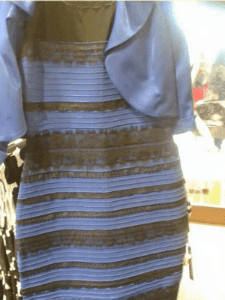
2015 has been nothing short of exciting and eventful for the optometry community! These 5 stories were some of the most buzzed-about topics relating to our profession this year.
5. #Dressgate
 In February of 2015, a viral photo originating from a washed-out photograph of a dress was posted on the social networking service Tumblr and Twitter, resulting in a world-wide dispute over whether the dress pictured was blue and black, or white and gold. In just 1 week after the image surfaced online, more than 10 million tweets mentioned the dress phenomenon.
In February of 2015, a viral photo originating from a washed-out photograph of a dress was posted on the social networking service Tumblr and Twitter, resulting in a world-wide dispute over whether the dress pictured was blue and black, or white and gold. In just 1 week after the image surfaced online, more than 10 million tweets mentioned the dress phenomenon.
Although the dress was confirmed to be blue and black, a poll of over 1,400 respondents found that 57% of individuals initially saw the dress as blue and black, 30% as white and gold, and about 10% as blue and brown. And, approximately 10% of people could switch between any of the color combinations. This controversial image prompted many discussions surrounding the optical illusion and why different people perceived the dress as being a certain color. I’m sure many of you all had friends, family members, and patients bombard you with questions regarding #dressgate in 2015!
4. Ophthalmology Resident Trashes Optometry
In early May of 2015, outrage in the optometry community ensued over a blog post by a first-year ophthalmology resident who discussed why ODs should not be performing medical treatments. In his initial post, he stated that allowing such practices would hinder patients and create an ophthalmic monopoly. He also noted that “anyone without a medical degree should basically prescribe glasses” and that “undoubtedly, those who can go to the MD will receive superior quality.”
These statements lead many optometrists to respond to the ophthalmology resident’s post in hopes of educating him regarding his clear ignorance and misunderstanding of the role of optometrists in the world of eye care. He then responded with a follow-up to his original post with more misleading comments, including a statement that “OD's efforts are better described as a wolf in sheep’s clothing.”
This story was an unfortunate reminder of the difficulties we as optometrists and optometry students continue to face in regards to the perception of what we do in the eyes of other medical practitioners. But let’s not let that get us down! Keep up the good fight!
3. VSP’s New Relationship with CVS
 CVS Health announced in early October of 2015 that it would begin providing optometric and optical services in its CVS/pharmacy stores starting with 5 locations in the Baltimore and Washington D.C. market. VSP stated that they would subcontract with doctors of optometry who choose to practice at those locations. Services would include comprehensive eye exams, prescriptions for glasses and contacts, access to lenses, frames and sunglasses, and free cleanings and adjustments of glasses. These CVS stores would also cary a selection of Marchon/Altair frames, offer VSP Optics lens brands, utilize VSPOne Lab network, and use Eyefinity practice management and electronic medical records software. CVS also announced that it would accept most of its consumers insurance plans.
CVS Health announced in early October of 2015 that it would begin providing optometric and optical services in its CVS/pharmacy stores starting with 5 locations in the Baltimore and Washington D.C. market. VSP stated that they would subcontract with doctors of optometry who choose to practice at those locations. Services would include comprehensive eye exams, prescriptions for glasses and contacts, access to lenses, frames and sunglasses, and free cleanings and adjustments of glasses. These CVS stores would also cary a selection of Marchon/Altair frames, offer VSP Optics lens brands, utilize VSPOne Lab network, and use Eyefinity practice management and electronic medical records software. CVS also announced that it would accept most of its consumers insurance plans.
This new relationship between CVS and VSP sparked a lot of discussion regarding the original mission of VSP which was thought to serve the independent doctor of optometry. It also brought up ethical issues as optometrists are concerned that these companies are acting in their own best interests and not taking into consideration the best interest of patients seeking quality eye care.
2. Opternative Launches Online “Eye Exam”
The Chicago-based company Opternative launched its online site in July of 2015 where consumers can get a prescription for glasses or contact lenses by completing a series of questions using their smartphone and computer. The refractive test is free, but it costs $40 for an ophthalmologist to review and approve a prescription for glasses, and $60 for a glasses and contacts prescription. Opternative claims that their refractive exam is as accurate as an in-person exam by an optometrist or ophthalmologist using a phoropter, and if users are not completely satisfied with their new Rx, they will provide a full refund. This service is currently available in 32 states.
The launching of this new website raised many concerns for eye care professionals throughout the US mostly because of the fact that consumers are perceiving this online refraction test as an “eye exam” while ocular health is not being evaluated. Just because a person can read 20/20 on a website at home does not mean that they do not have any ocular pathology and do not need a comprehensive eye health evaluation. It is also concerning that contact lenses are being prescribed from this site without evaluating the health of the cornea or checking the fit of the lenses on the eyes. Currently, the American Optometric Association along with state associations are working to determine the legality of this website and the implications it has on our patient’s safety.
1. ICD-10 Implementation
After being postponed several times, ICD-10 conversion was mandated to begin on October 1st, 2015. This topic was talked about as if the apocalypse was about to hit the medical profession. The goal of the ICD-10 conversion was to update the 30-year old ICD-9 coding system and add specificity to codes in hopes of providing more accurate payment for procedures, resulting in fewer rejected and improper claims, and allowing for a better understating of new procedures and improved disease management.
The biggest concern for ODs was that there would be difficulty in finding the proper codes for certain medical conditions because of the shear increase in the amount of codes available, and the format of the codes. ODs were worried that this conversion would disrupt the claims process and reimbursement in the months following the change.
Although a major pain, the conversion of ICD-10 seemed to run pretty smoothly for most practitioners. There were many billing and coding classes, webinars, websites, apps, forums, and books to help with the conversion. Additionally, most practice management and medical records software were updated to help with coding. Some ODs have noted difficulty with certain claims and codes being rejected, but for the most part, the ICD-10 conversion was not as bad as it was cracked up to be!
Anything we missed? Feel free to comment below!
-Dr. Dexter
The Top 15 Tips and Tricks for Studying for Part I of NBEO®

We’ve put together a ton of great tips and tricks for studying for Part I of NBEO along with two tailored study programs that will help you thoroughly prepare for the big day. Remember, you’ve made it this far and you can totally do this!
Some of the Top 15 Tips include:
- Familiarize Yourself with the Test Format
- Tackle the Weak Subjects Early
- Start Sooner and Ease Into It
- ...and 12 more!

